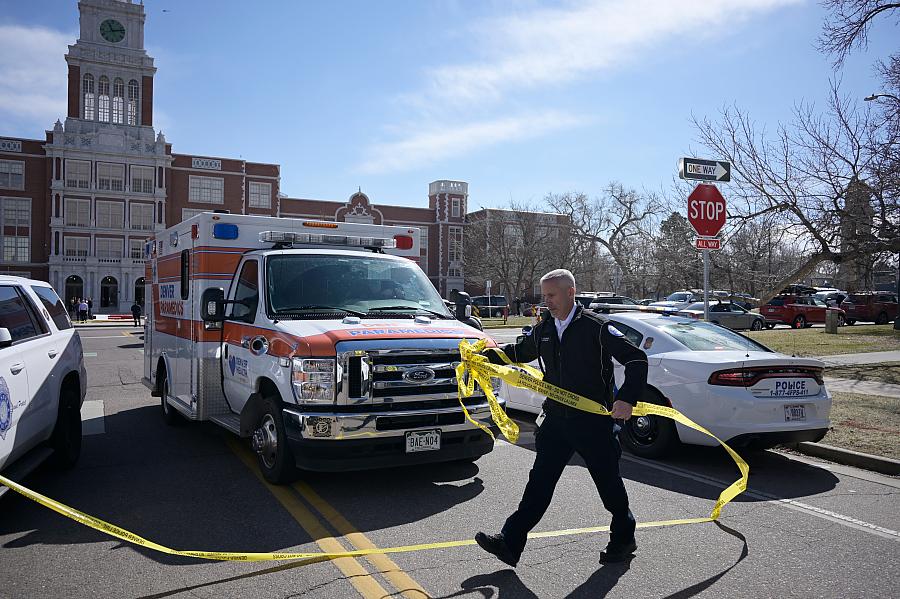A new investigation looks at how Colorado schools are struggling to discipline students after the pandemic

Police investigate at Denver's East High School after a shooting there on Wednesday, March 22, 2023.
(Photo by Hyoung Chang/The Denver Post)
In the summer of 2020, as Colorado children struggled with the far-reaching toll of the pandemic, school and health officials said they expected to see a “tsunami of need” for mental health care.
And in the years since students returned to their schools, which had shuttered in early 2020 to curb the spread of the coronavirus, administrators and teachers have reported increased absenteeism and behavioral issues among their pupils. Schools also are struggling with staffing shortages.
Children themselves said they struggled to adapt to the strict routine of in-person learning. They said sitting at a desk became harder after they were able to move freely during lessons at home. They had shorter attention spans, but faced more pressure to perform well academically.
At the same time, the number of children expelled and suspended from schools increased statewide, with Colorado school districts handing out more severe discipline during the 2021-22 academic year than they did in 2019-20.
More than 83,400 Colorado children were suspended during the 2021-22 academic year and just under 800 students were expelled from school, according to the latest data from the Colorado Department of Education.
Schools aren’t just expelling and suspending more kids for severe infractions, such as bringing weapons to campus. They are also doing so for behaviors like destroying property and substance and alcohol use, according to the data.
My 2023 Data Fellowship project is an investigation into school discipline in Colorado that looks at not just who is being suspended and expelled and why, but digs into the system itself and how well it serves students — especially amid the teen mental health crisis.
This project comes not just as children are struggling with their mental health, but as Colorado’s largest school district is coming under intense scrutiny for how it handles student discipline following a March shooting at East High School in Denver.
After the shooting, which took place at the city’s largest high school, there have been growing calls for Denver Public Schools (DPS) to send students with significant disciplinary issues to alternative or virtual schools. The student who shot two administrators at East previously had been expelled from a neighboring district while on probation for a weapons charge.
DPS officials have argued the district has a “moral obligation” to teach students and has sought to reduce expulsions and suspensions in recent years — a stance the district’s superintendent has since reiterated in an opinion piece published in The Denver Post.
The district has said it is wrestling with rising gun violence among teens, a problem affecting not just Denver’s schools but the city as a whole. More teens are dying from gun violence — and in many cases, the perpetrators are their peers, according to data analyzed by The Post.
The shooting also has indirectly spotlighted the practices of de-escalation, seclusion and restraint in schools.
In August, DPS school board members revealed the district was investigating the use of a “seclusion room” at one of the city’s middle schools. The probe found that the use of the room violated district policy because students were placed in the space alone with the door either locked or held shut.
The principal of the school, whom DPS fired after he spoke publicly about safety issues following the East High shooting, said he placed students in the room, but faced budget constraints when creating the space.
The district’s principal union has since asked DPS for more crisis and de-escalation training, saying in a letter sent to DPS’ superintendent that, “Post-COVID, most leaders in DPS are regularly managing extremely volatile, trauma-based behaviors not limited to students with disabilities …”
“These behaviors jeopardize the safety of students and staff,” the Denver School Leaders Association wrote in the Aug. 24 letter. “In many schools across the district, school leaders are trying to maintain safety without the adequate training, support or resources to effectively care for students in crisis and to keep all students safe.”
Nationally, there has been growing awareness about the mental health struggles of teens. However, there has not been a comprehensive look at how Colorado school districts are responding to behavioral challenges while struggling with staffing shortages and possible budget constraints brought on by declining enrollment.
For this project, The Post will analyze state data to better understand how school districts across Colorado are disciplining students, and which factors are driving the rise in expulsions and suspensions.
